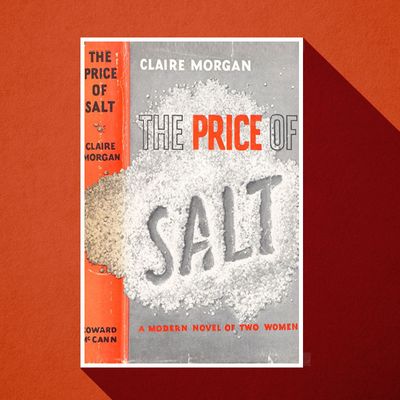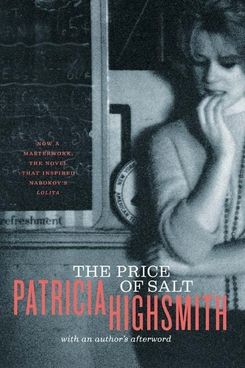
Novelist Emily M. Danforth, author of The Miseducation of Cameron Post and Plain Bad Heroines, hadn’t yet come out when she first encountered this passage from Patricia Highsmith’s The Price of Salt back in her 20s. At the time, she wished the scene had been more anatomical. Today, it’s Highsmith’s sublime metaphors that pull her in. Although she appreciates Todd Haynes’s film adaptation, Carol, Danforth insists there’s something inevitably missing from this iconic scene. “She’s a fucking comet arcing into space,” Danforth says. “That’s something you can only do in prose, that you can’t mimic with two actors in a hotel stage room.”
“Carol’s fingers tightened in her hair, Carol kissed her on the lips, and pleasure leaped in Therese again as if it were only a continuation of the moment when Carol had slipped her arm under her neck last night. I love you, Therese wanted to say again, and then the words were erased by the tingling and terrifying pleasure that spread in waves from Carol’s lips over her neck, her shoulders, that rushed suddenly, the length of her body. Her arms were tight around Carol, and she was conscious of Carol and nothing else, of Carol’s hand that slid along her ribs, Carol’s hair that brushed her bare breasts, and then her body too seemed to vanish in widening circles that leaped further and further, beyond where thought could follow. While a thousand memories and moments, words, the first darling, the second time Carol had met her at the store, a thousand memories of Carol’s face, her voice, moments of anger and laughter flashed like the tail of a comet across her brain. And now it was pale-blue distance and space, an expanding space in which she took flight suddenly like a long arrow. The arrow seemed to cross an impossibly wide abyss with ease, seemed to arc on and on in space, and not quite to stop. Then she realized that she still clung to Carol, that she trembled violently, and the arrow was herself. She saw Carol’s pale hair across her eyes, and now Carol’s head was close against hers. And she did not have to ask if this were right, no one had to tell her, because this could not have been more right or perfect. She held Carol tighter against her, and felt Carol’s mouth on her own smiling mouth. Therese lay still, looking at her, at Carol’s face only inches away from her, the gray eyes calm as she had never seen them, as if they retained some of the space she had just emerged from. And it seemed strange that it was still Carol’s face, with the freckles, the bending blond eyebrow that she knew, the mouth now as calm as her eyes, as Therese had seen it many times before.
‘My angel,’ Carol said. ‘Flung out of space.’ ”
It begins with “terrifying pleasure,” this pleasure that’s so big that Therese is scared of it even as she’s walking into it. But then the physical descriptions fall away. There’s such specificity there — the use of leaped, her body vanishing in widening circles, that beautiful line “beyond where thought could follow.” And then suddenly Patricia Highsmith is reminding us of all those things that have happened to Therese and Carol to get to this moment. If there was a handbook for writing an erotic scene, I’m sure it would say “Don’t do that.” You can’t pull out of the moment — we’ve lost the hair on the breasts and the tingling pleasure. But that’s what I love about the scene.
Highsmith was adept at constructing these very tightly plotted crime novels, and she brings that talent to bear in The Price of Salt. From the moment Therese encounters Carol in the department store, we are really building toward this scene more than a hundred pages later. That also puts an unbearable pressure on this scene to work.
Throughout the novel, Therese is looking for instruction from Carol as though she’s filling some sort of parental void. So this is an incredibly profound moment, one that’s so recognizable to me as a queer woman — that Therese has a certainty, and she doesn’t need it defined or explained or sanctioned by any outside force.
I spent a good part of my late teens and early 20s reading all the lesbian lit I could in order to be the best lesbian I could be when I came out. When I first read the scene, in my mid-20s, I didn’t want it to be artful. I wanted it to be an instruction manual. It does feel goofy to admit that, but I really wanted to do it correctly. This was in the late ’90s and early aughts. I read a lot of upsetting lesbian books; I started with The Well of Loneliness and worked my way from there, stories where the queer couple are punished in some way. Reading this book, even some 48 years after it had been published, had a huge effect on me — the hopefulness, the endorsement of Therese’s feelings.
Now, when I reread the passage, it’s the missing anatomy that I love. I’m filling in the details. Highsmith allows space for the reader to do that work at exactly the right moment. She’s taking the reader into the realm of the ineffable. As a young reader, that is what I wanted the experience of sex to be like. I knew I had these desires, but to act on these desires — that terrain still felt very fraught to me. So this idea that sex would be so beautiful I wouldn’t even be able to find the words for it, that felt very important.
This scene lodged so firmly in my brain that it bubbles up in ways I’m not always aware of when I’m writing. There’s a moment in my new book when three of the characters make out in an orchard, and each of them is thinking in these really specific, sensory terms of images that they’re going to remember later. I love that shift from tactile writing into metaphoric writing that allows the reader to fully live in a scene so that it feels true, which is really what I ask of fiction.
*This article appears in the October 12, 2020, issue of New York Magazine. Subscribe Now!



